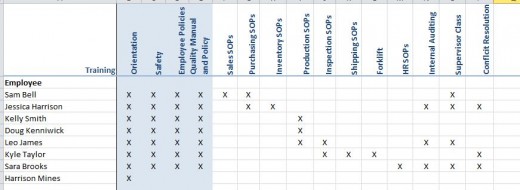It can be challenging to keep track of which employee has had what training, even in a small company. One good way to track it is with a training matrix:
A matrix like this lets you quickly find out what training an employee has had and needs (you can easily see that Harrison is a new employee and needs safety training next). It also answers questions like “Who is trained to use the forklift?” The matrix can be expanded to cover all the machinery or processes that need training, as well as the professional development classes employees attend.
SOPs for various departments are listed because, if you have written procedures, reading them is a good way to get employees oriented to their new job; it is also important to do if you are ISO-certified, or trying to become so, as a way to prove that your employees have appropriate training. This could be expanded to include relevant Safety Data Sheets for employees that regularly work with chemicals, or any other documentation they should read (but shouldn’t replace sign-off or acknowledgement sheets).
A training matrix is filed with HR or training department, not in individual employee training files. Data is added based on attendance sheets for in-house training, certificates added to training files for other classes, or any other mechanism that will get the information in the table reliably.
The matrix takes time to set up initially and some routine maintenance, but once you have it, it makes answering training questions much easier.

